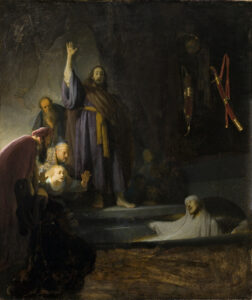Believing Into….
Co-missioners,
From our editor: an observation this week on a huge little thing in the text of John.
Peace and Joy,
The Crossings Community
________________________________________________________________
“Believing Into…”
by Jerome Burce
A few days ago I finally spotted something in the Greek of St. John’s Gospel that I wish I had noticed years ago.
That I did so now is due entirely to a thoughtful friend whose identity I’ll hide under the name Mary. Earlier this month Mary sent me a note raising questions about things she had noticed in church that morning while listening intently to a reading from John 3. That’s where Jesus is having his nighttime conversation, if conversation it is, with Nicodemus.

JESUS MAFA. Nicodemus, from Art in the Christian Tradition, a project of the Vanderbilt Divinity Library, Nashville, TN. https://diglib.library.vanderbilt.edu/act-imagelink.pl?RC=48385
Few are those who attend so well to so well-known a reading—but, yes, that’s Mary, she of the Spirit-induced thirst for the Word of Life. Like countless others, she can rattle off John 3:16 by rote. Unlike others, she pauses to wonder what Jesus is implying when he says that “…whoever believes in him will have eternal life.”
“Believing in him: that sounds like work, as in something I have to do. Can’t we say instead, ‘Whoever trusts him?’ That seems more possible.”
Thus a paraphrase of part of Mary’s note. It sent me scrambling for the Greek text. And what I saw at last was a not-so-little thing having to do with little prepositions. In Greek there is en and there is eis. The English approximations are in and into. The first has a static quality to it. It suggests arrival or presence at a specific location. The second is more fluid. It connotes movement from one place to the next. If I’m “in” the house, that’s where I am, the doors shut behind me more likely than not. By contrast, if I say “into” the house, I imply progression to where I plan to be, or perhaps where someone else is taking me. The point is, I’m not there yet, or at least not altogether. I’m still going in, still moving in, the door still open as I near the threshold or step across it.
“Whoever believes eis [into] him….” That’s what John’s Greek says, and not only in 3:16, but wherever else the “believing” word pops up—in, say, the back-and-forth between Jesus and Martha in John 11:25-26 that Mary and all the rest of us will hear this coming Sunday. Literally: “Everyone who is living and believing into me will never die.”
Is that terrible English? Yes. Then again, it’s magnificent Gospel. It cuts away the burden that I think was hanging from Mary’s neck—the same burden that has hung for centuries from countless other Christian necks. Many who read this will have felt it themselves along the way. It comes wrapped in a question that the devil promulgates through unwitting Sunday School teachers and youth workers, to say nothing of pastors, preachers, and poor theologians: “Do you really believe?” As if faith in Jesus can be quantified. As if there’s a minimum degree of confidence that has to be achieved for a person to cash in on the Jesus-goodies of forgiveness, life, salvation.
It bears noting on this near-cusp of Holy Week that the crook to Jesus’ right on Golgotha did nothing more than to believe into Jesus. He does this feebly, pathetically even. He merely cranes his head in Jesus’ direction. He croaks “Remember me.” The cynic does well to write him off as self-server clutching at straws. We can’t suppose the fellow has the faintest clue as to who-all Jesus really is.
No matter. “We’re going home,” Jesus says.
When I mentioned some of this to Mary, I got the following response:
“I’m glad to understand better what the Greek signifies. If this isn’t too profane, I’ll say that it made me think of that group dance…called the Hokey-Pokey. It starts out ‘You put your right foot in, you put your left foot in,’ etc., etc., and then it ends up ‘you put your whole self in.’”
To which I responded in turn:
“I think your Hokey Pokey analogy is ‘spot on,’ as the Brits say…. It certainly describes what’s going on with the disciples throughout John’s Gospel. It describes us too in our lives as “wannabe believers,” so to speak—never altogether getting there, yet constantly putting this, or that, or the other piece of us into the dance of faith. Come to think of it, it’s this constant “putting in” that preachers are meant to encourage. And here I mean preachers in the broadest sense, to include anyone who encourages another to take Christ seriously as the Way, the Truth, the Life, and to practice doing this. The old square dancing featured callers who did as the song does in Hokey Pokey. Not a bad way of thinking about our Christian vocation over against each other.”
Our calling, you might say, is to call each other into faith—for now a stumbling, bumbling dance of faith centered on the Caller of Callers who stands in the middle of the cosmic floor as the One who owns us, having “purchased and won us” from the pitchmen for all those other death-dealing dances we’re addicted to as Adam’s children. It tickles this Caller no end to see toes tapping to the beat he sets. A toe that merely twitches will put a smile on his face. Or so the scriptural record keeps telling us when we listen as closely on Sunday as Mary does.
With this I quit for now, having pushed my friend’s analogy to its limits. If nothing else, may this serve to help a preacher or two think freshly about their job in coming days as they careen toward Holy Week.
Next Thursday we’ll send you more on this matter of faith and believing and the Christ who’s at the heart of it. You’ll get it in the form of a little essay by Robert W. Bertram that lies unnoticed in our Crossings library. Here’s a teaser to whet your appetite:
“What we are meant to be is plausible—literally, pleasing—and confident that we are plausible. That is what Paul calls faith: confidence that we have the Creator’s applause.”
Which Mary has, by the way—the Creator’s applause, that is. I suspect she’ll be as hesitant as the rest of us to admit this about herself, but there it is. It’s the very thing that comes of believing into Jesus, the One the Father set to get people on their feet again. Even the likes of dead Lazarus, as we’ll hear again in a couple of days.
Thursday Theology: that the benefits of Christ be put to use
A publication of the Crossings Community

